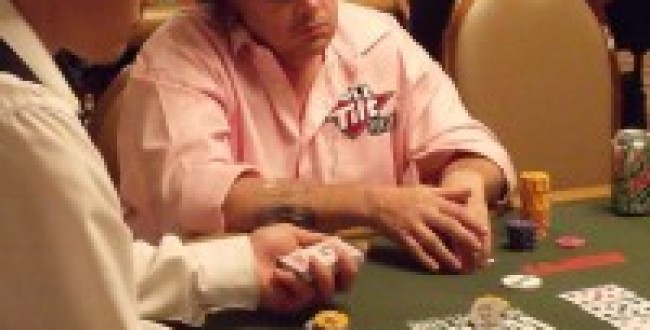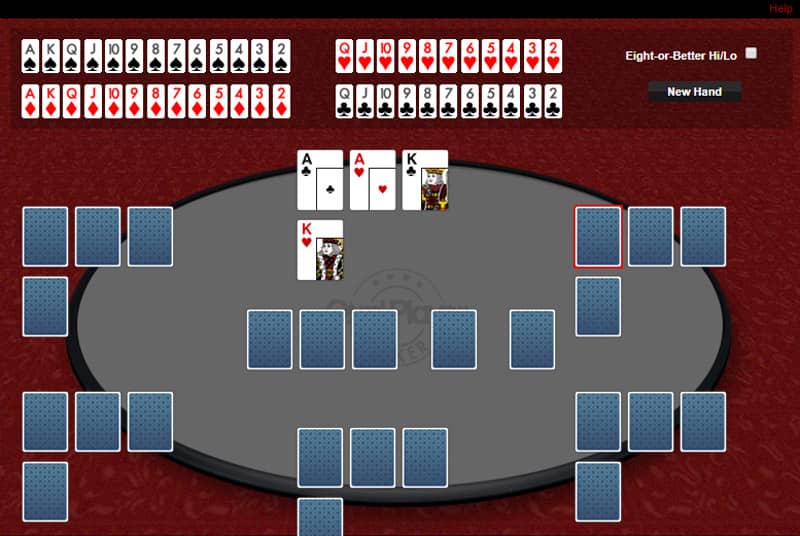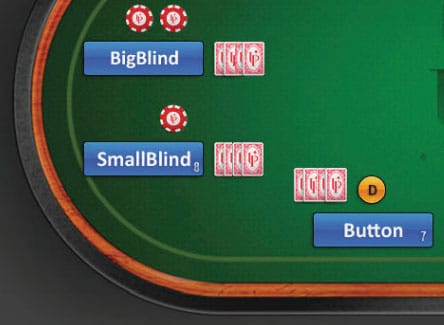Nl Omaha Hi Lo Rules
The full name of Omaha Hi/Lo is actually Omaha Hi/Lo split, Eight or better. Since that is a bit of a mouthful, everyone calls it simply 'Omaha Hi/Lo'. However, what does 'split, Eight or better' actually mean? The 'split' part is easy that is just the fifty-fifty split between the winner of the high hand and the winner of the low. The best possible lo hand in Omaha Hi Lo is the same as Razz and consists of 5432A, otherwise referred to as the “Wheel”. Lo Omaha hands do not take straights or flushes into consideration.
Owing to its frequently large pots, Omaha Hi/Lo (also called ‘Omaha High Low’, ‘Omaha H/L’, ‘Omaha/8’ or ‘Omaha 8-or-better’) has become a hugely popular game around the world. Each player in an Omaha Hi/Lo game is dealt four private cards (‘hole cards’) that belong only to that player. Five community cards are dealt face-up on the ‘board’. All players use exactly two cards from their four hole cards in conjunction with exactly three cards from the board to make the best five-card poker hand possible. The pot is divided between the best hand for high and the best hand for low – hence the name, Omaha Hi/Lo. You may use different combinations of two cards from your hand to make your high hand and your low hand, but in each hand you must use precisely two from your hand and three from the board – no more, no less. Visit the poker hands page to view the rankings of hands in Omaha Hi/Lo.
Omaha Hi/Lo is played with an ‘8-or-better’ qualifier, which means that a low hand must consist of five different cards – ranked eight or below – to be eligible to win the low portion of the pot. Low hands in Omaha Hi/Lo are determined in exactly the same way they’re determined in 7 Card Stud Hi/Lo. If there is no qualifying low hand, the high hand wins the entire pot.
Nl Omaha Hi Lo Rules 2020
Omaha Hi/Lo uses the ‘Ace to Five’ or ‘California’ system for ranking low hands. Straights and flushes do not count against a hand, and Aces are always low in reading the low hand, so the best possible hand is a ‘wheel’: 5, 4, 3, 2, A. To help understand the ranks of low hands, the following sample qualifying low hands (not a complete list) are ranked from least powerful (#1, will rarely win the low half of the pot) to most powerful (#10, the nuts):
- 8, 7, 6, 5, 4
- 8, 7, 6, 5, 3
- 8, 6, 4, 2, A
- 8, 4, 3, 2, A
- 7, 6, 5, 4, 2
- 7, 6, 5, 2, A
- 7, 5, 4, 3, 2
- 6, 5, 4, 3, 2
- 6, 4, 3, 2, A
- 5, 4, 3, 2, A
Note that a low hand is always ranked from its highest card downwards. So for example, hand #9 is known as a ‘Six-low’ because its highest card is a Six. Hand #5 is a ‘Seven-low’, and Hand #1 is an ‘Eight-low’. In poker slang, you distinguish between close low hands by going further down the ranks, so hand #9 would be called a ‘Six-Four low’, which beats hand #8, a ‘Six-Five low’.
Also remember that straights and flushes do not count against your low hand, so making a qualifying low that is also a straight or a flush is a very powerful hand, that could win both the high and low halves of the pot. That’s called a ‘scoop’.
Types of Omaha Hi/Lo Games
Omaha Hi/Lo can be played in the following formats:
- Limit Omaha Hi/Lo – Specific betting limit applied in each game and on each round of betting.
- Pot Limit Omaha Hi/Lo – Bets are limited to the amount of chips in the pot.
- No Limit Omaha Hi/Lo – A player can bet all of the chips he has available.
- Mixed Omaha Hi/Lo – The game alternates between rounds of Limit and Pot-Limit. The blinds are increased when the game switches from Pot-Limit to Limit, to ensure that the stake levels are consistent.
Rules for Playing Omaha Hi/Lo
In Omaha Hi/Lo, a marker called ‘the button’ or ‘the dealer button’ indicates which player is the nominal dealer for the current game. Before the game begins, the player immediately clockwise from the button posts the ‘small blind’, the first forced bet. The player immediately clockwise from the small blind posts the ‘big blind’, which is typically twice the size of the small blind, but the blinds can vary depending on the stakes and betting structure being played.
In Limit games, the big blind is the same as the small bet, and the small blind is typically half the size of the big blind but may be larger depending on the stakes. For example, in a $2/$4 Limit game the small blind is $1 and the big blind is $2. In a $15/$30 Limit game, the small blind is $10 and the big blind is $15.
In Pot Limit and No Limit games, the games are referred to by the size of their blinds (for example, a $1/$2 Omaha Hi/Lo game has a small blind of $1 and a big blind of $2).
Now, each player receives their four hole cards. Betting action proceeds clockwise around the table, starting with the player ‘under the gun’ (immediately clockwise from the big blind).
Pre-Flop
After seeing his or her hole cards, each player now has the option to play his or her hand by calling or raising the big blind. The action begins to the left of the big blind, which is considered a ‘live’ bet on this round. That player has the option to fold, call or raise. For example, if the big blind was $2, it would cost $2 to call, or at least $4 to raise. Action then proceeds clockwise around the table.
Note: The betting structure varies with different variations of the game. Explanations of the betting action in Limit Omaha Hi/Lo, No Limit Omaha Hi/Lo, and Pot Limit Omaha Hi/Lo can be found below.
Betting continues on each betting round until all active players (who have not folded) have placed equal bets in the pot.
The Flop
After the first round of betting is complete, the ‘flop’ is dealt face-up on the board. The flop is the first three community cards available to all active players. Betting begins with the active player immediately clockwise from the button. Another round of betting ensues. In Limit Omaha Hi/Lo, all bets and raises on the flop are in increments of the small bet (for example, $2 in a $2/$4 game).
The Turn
When betting action is completed for the flop round, the ‘turn’ is dealt face-up on the board. The turn is the fourth community card in an Omaha Hi/Lo game. Play begins with the active player immediately clockwise from the button. Another round of betting ensues. In Limit Omaha Hi/Lo, bets and raises on the turn are in increments of the big bet (for example, $4 in a $2/$4 game).
The River
When betting action is completed for the turn round, the ‘river’ is dealt face-up on the board. The river is the fifth and final community card in an Omaha Hi/Lo game. Betting begins with the active player immediately clockwise from the button. A final betting round ensues.
The Showdown
If there is more than one remaining player when the final betting round is complete, the last person to bet or raise shows their cards, unless there was no bet on the final round in which case the player immediately clockwise from the button shows their cards first. The player with the best five-card hand for high wins half the pot, and the player with the best five-card hand for low wins the other half. Remember, in all Omaha games, players must use two (and only two) of their four hole cards in combination with exactly three cards from the board. In the event of identical hands, the high and low shares of the pot will be equally divided between the players with the best hands. In the event that no hand qualifies for low (i.e. is an ‘eight low’ or better), the best hand(s) for high wins the whole pot.
After the pot is awarded, a new Omaha Hi/Lo game is ready to be played. The button now moves clockwise to the next player.
Limit, Pot Limit, No Limit Omaha Hi/Lo
Omaha Hi/Lo rules remain the same for Limit, No Limit and Pot Limit poker games, with a few exceptions:
Limit Omaha Hi/Lo
Betting in Limit Omaha Hi/Lo is in pre-determined, structured amounts. Pre-flop and on the flop, all bets and raises are of the same amount as the big blind. On the turn and the river, the size of all bets and raises doubles. In Limit Omaha Hi/Lo, up to four bets are allowed per player during each betting round. This includes a (1) bet, (2) raise, (3) re-raise, and (4) cap (final raise).
Pot Limit Omaha Hi/Lo
The minimum bet in Pot Limit Omaha Hi/Lo is the same as the size of the big blind, but players can always bet up to the size of the pot.
Minimum raise: The raise amount must be at least as much as any previous bet or raise in the same round. As an example, if the first player to act bets $5 then the second player must raise a minimum of $5 (total bet of $10).
Maximum raise: The size of the pot, which is defined as the total of the active pot, plus all bets on the table, plus the amount the active player must first call before raising.
Example: If the size of the pot is $100, and there is no previous action on a particular betting round, a player may bet a maximum of $100. After that bet, the action moves to the next player clockwise. That player can either fold, call $100, or raise any amount between the minimum ($100 more) and the maximum. The maximum bet in this case is $400 – the raiser would first call $100, bringing the pot size to $300, and then raise $300 more, making a total bet of $400.
In Pot Limit Omaha Hi/Lo, there is no ‘cap’ on the number of raises allowed.

No Limit Omaha Hi/Lo
The minimum bet in No Limit Omaha Hi/Lo is the same as the size of the big blind, but players can always bet as much more as they want, up to all of their chips.
Minimum raise: In No Limit Omaha Hi/Lo, the raise amount must be at least as much as the previous bet or raise in the same round. As an example, if the first player to act bets $5 then the second player must raise a minimum of $5 (total bet of $10).
Maximum raise: The size of your stack (your chips on the table).
In No Limit Omaha Hi/Lo, there is no ‘cap’ on the number of raises allowed.
Omaha Hi/Lo is growing very fast in popularity, especially with the exposure of online poker. So while learning the rules of Omaha Hi/Lo can take some getting used to, it is an entertaining poker variant that many players have learned to enjoy.
Learn How to Play Omaha Hi/Lo for Free
If you are unfamiliar with Omaha Hi/Lo, we recommend you try that poker game out to get a feel for how the game is played. You are always welcome to play on the free poker tables at the poker rooms, so that you can sharpen your skills before playing real money poker.
Objective
Playing a Hand of Omaha Hi-Lo
Hand RankingsIt's necessary to split up our hand rankings into two parts here. The hi-card hands and the lo-card hands. The hi-hands are exactly the same as in Omaha-hi and are as follows.
Omaha High-Hands

Omaha Low Hands
- Flushes and straights do not count against our hand. The nut lo-hand is therefore A,2,3,4,5. Remember that we must use exactly two of our hole-cards for the lo-hand also. These don't have to be the same 2-cards that we use for the hi-hand however. So if we hold AQJK, and the board is 2,3,4,5,Q we do not have the nut-low and we do not have a straight for a decent hi-hand. We actually have pair of Queens and no low-hand.
- Aces are always lowunlike in other variants such as 2-7 triple draw. If we struggle to read lo-hands, we simply should think of them as a number. For example it's a common beginners mistake to assume that A,2,3,4,7 is a better hand than 2,3,4,5,6. If we read them backwards as numbers – I.e 74,321 and 65,432 it should be pretty easy to see that the second hand is lower and therefore stronger. We can refer to the first hand as a 7-low and the second hand as a 6-low. The nuts, A,2,3,4,5 is referred to as the “nut low”.
- Suits are not relevant to the strength of our hand unlike other variants such as Stud. Equivalent hi-hands will chop the high pot regardless of the suits contained.
- Low hands must “qualify”. In order for a low hand to “qualify” it needs to contain 5 cards below an 8. Remember that only two of these can be from our hole-cards. This means that it is impossible for anyone to have a qualifying low hand if there are not at least 3 cards below an 8 on the board. In such situations Omaha-hi/lo plays like the regular Omaha-hi. There is no low pot awarded and the best hi-hand scoops the entire pot.

Betting Structure
While initially Omaha-8 was primarily played with a fixed-limit betting structure, PLO8 has rapidly become more popular and is the most common format of the game played. In recent years NLO8 tables have begun to spring up on certain networks.Why Play Omaha-8?
- Omaha-8 is hugely challenging, even when it comes to simple things like understanding the strength of our hand. This can be complicated enough in the Omaha-hi variant when we have a wrap and flush-draws going on at the same. Now imagine this situation but we are also at the same time calculating what our current low-hand is or our percentage chance we will hit our low-draw. Initially we may even feel that playing a single-table of this variant takes our full focus and concentration.
- Due to the challenging nature of Omaha-8 games, the competition is relatively soft. Very few players understand good strategy – and many do not even understand fully how to read the strength of their hand. Some are even surprised that they have chopped the pot with someone since they thought they were playing Omaha-hi.
- Omaha-8 is a lot lower variance than hold'em or Omaha. This is to do with the split-pot nature of the game. In the majority of showdown situations we are not going to be losing the entire pot. We will often end up splitting or quartering the pot. This means that going on prolonged downswings is less likely assuming that we have a winning strategy. As a result we can get away with lighter bankroll requirements and play higher stakes. Low variance, soft-games, a fun challenge. What more could we want!


Omaha-8 Pointers
- Play to Scoop! - The number one beginner mistake in this game is that players are aiming to win only one of the two pots. They'll typically decide each round whether they are trying to make a hi-card hand or a lo-card hand. This is not going to be a winning strategy in the long run. Our objective is to scoop both pots as much as possible.
- Starting Hands – Some of the hands that are decent starting hands in Omaha-hi are actually not decent starting hands in Omaha-8. Firstly we are looking to play hands that contain an Ace and a Two in most cases, to maximise our chances of making the nut-low. Something like As2sAd3d would be an excellent starting hand. Notice how we have nut-flush potential in 2 suits and also excellent nut-low potential.
- Avoid Mid-Rundowns – Rundowns are excellent starting hands in Omaha-hi. For example 6s7s8d9d. These are horrible hands in Omaha-8. In many cases to make a decent straight with this hand it means that there is likely to be a qualifying low available. So we can basically never win the entire pot. Even though such a hand can qualify for a low-hand it's rarely going to be the best low-hand since it will usually be an Seven-Six-low.
- Counterfeiting – It's useful to be aware of this concept since we can get into trouble if not. Let's say we hold A2 and the board texture is 8,7,5. We have the absolute best nut-low. A,2,5,7,8. However let's the say the turn card comes a 2. We have now been counterfeited. Why is this? Our absolute hand-strength has not changed, but our relative hand-strength has changed. If opponent has A3 he now has A,2,3,5,7 for Seven-low which will beat our A,2,5,7,8 for Eight-low. Holding A23x on the 8,7,5 board gives us counterfeit protection, because if that 2 falls we still hold the nut-low.